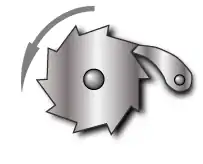Pawl
A pawl is a mechanical component that engages with another component to prevent movement in one direction, or prevent movement altogether. It is a type of latch. It consists of a spring-loaded solid part that is pivoted at one end and engages the other component at a steep angle at the other end. Pawls are often tapered, being wide at the pivoting end and narrow at the engaging end.

A ratchet and pawl mechanism
Applications
- Anchor windlass
- A pawl is used in an anchor windlass to prevent a free-spooling chain by grabbing and snubbing an individual link. Similar mechanisms include a Devil's claw and dog.
- Ratchet
- A pawl is used in combination with a ratchet gear in socket wrenches, bicycle freehubs, winches, and many other applications.[1][2]
- Ladders
- Dogs and pawls are used on extension ladders to prevent the ladder sections from sliding relative to each other.[3]
- Table saw
- Pawls are used on table saws to grip the workpiece and prevent kickback.[4]
.png.webp)
Pawl brake assembly
- Parking
- A parking pawl is a device fitted to the automatic transmission of motor vehicles to lock it up when the vehicle is parked and to prevent it from moving.[5]
References
- Nitaigour Premcahnd Mahalik, Mechatronics: Principles, Concepts and Applications, p. 271, Tata McGraw-Hill Education, 2003 ISBN 0070483744.
- Richard Krolak, Cruising World, "Servicing your winches", April 1990, pp. 107-108
- International Association of Fire Chiefs, Fundamentals of Fire Fighter Skills, p. 363, Jones & Bartlett Publishers, 2012 ISBN 1449666507.
- Table Saw Techniques: Use Your Saw Like a Pro, p. 12, Quarto Publishing Group USA, 2003 ISBN 1610602951.
- Keith Santini, Kirk Vangelder, Automotive Automatic Transmissions and Transaxles, p. 174, Jones & Bartlett Learning, 2017 ISBN 1284122034.
This article is issued from Wikipedia. The text is licensed under Creative Commons - Attribution - Sharealike. Additional terms may apply for the media files.
